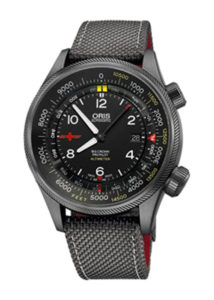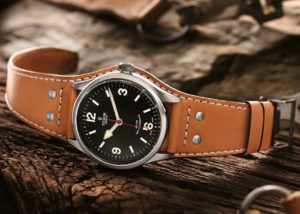
Colors, functions, accessories : military watches come in a variety of uniforms as diverse as the armies that inspire them. They nonetheless share a number of design codes for which GMT suggests a deciphering exercise.
Paul O’NEIL
Chief Editor of WorldTempus.com
The three branches of the military have each made their own contributions to the development of the wristwatch. Infantrymen in the first world war were among the first to start wearing watches on the wrist, creating a whole new watch genre called the “trench watch”. Not long after, pilots did the same and their need for precise timing in waypoint navigation led to functions like the flyback chronograph hand. At the extreme, Officine Panerai, famous for its dive watches for Italian navy frogmen in the second world war, produced solely for military customers right up until the 1990s. Scan the QR code to see more military-inspired watches on WorldTempus.
The military watch is engaged in a campaign to conquer wrists the world over. Utilitarian, pragmatic and robust, it boasts all the advantages of its functional nature. In parallel, however, the fashion world is eagerly adopting its aesthetic codes in terms of both colors and design. What’s more, given its role as standard issue provided by various States, it has historically been relatively inexpensive, a strong argument in this day and age. The military watch is thus modest-looking and appears mainly in steel, occasionally in titanium and never in gold. It is fairly large in order to remain eminently legible as befits its stature. Finally, it is built for action on the ground, at least in theory, and is thus expected to be both rugged and reliable. Exit slim cases and fragile complications. The last aspect is its means of attachment. Leather straps age less gracefully than metal and woven synthetic fibers. And if it can in passing be transformed into a tool or instrument, all to the good !
AIR
To calculate their speed and trajectory, fighter pilots need a chronograph. And so as not to waste precious time resetting it before restarting a timing operation, they have adopted the flyback function as their favorite complication. Historically, the standard was set by the French Naval Aviation and its Type XX specifications. Breguet was the original supplier and continues to provide these large timepieces, at a relatively hefty price. Meanwhile, bombardiers had the B-Uhr. To help them drop their munitions at an exact time, they wore wide wristwatches featuring separate and contrasting minutes and hours scales, a tradition still cultivated by Bell & Ross. And to take things to the next level, Oris even offers Altimeter models bearing an altitude scale graduated in feet or meters.
- BELL & ROSS WW1-92 Military
- BREGUET Type XXI ref.3817
- ORIS Altimeter Rega Limited Edition
LAND
Foot soldiers do not require advanced functions, but rather the ability to merge into their surroundings, which is why military watches tend to stick to three color codes. The first is olive green, which has never been trendier. TAG Heuer has leapt into the breach with an Aquaracer Khaki. The second is somewhat rarer, but sandy shades have always been part of the military watch design vocabulary, as in Hamilton’s recently revamped Khaki Field. The third and last is camouflage. Whatever the color, it’s the motif that counts. It must sow confusion and blur visibility, an approach that Graham has interpreted in many different ways.
- GRAHAM Chronofighter Limited Edition Navy Seal
- TAH HEUER Aquaracer Khaki Calibre 5
- HAMILTON Khaki Field Mechanical
SEA
The diver’s watch owes almost everything to armed forces : its readings, its norms, its legendary models. But when all is said and done, the most interesting interpretations are those linked with commandos. Their color is black, preferably total black. Panerai has chosen it to attire one of its most advanced watches : the PAM 616. This diver’s model is equipped with a case made of Carbotech, a high resistance composite material striped like the skin of a tiger shark. Nonetheless, the Navy is not all about underwater feats. Ulysse Nardin perpetuates the tradition of deck chronometers. These extremely broad, ultra-legible models with large numerals have never had blue dials. Cream or black reign supreme, as exemplified in the Marine Torpilleur models.
- ULYSSE NARDIN Marine Torpilleur
- PANERAI Luminor Submersible 1950 Carbotech 3 Days Automatic, PAM616
WRIST
NATO has never been as ‘hot’ as it now is. Named after the chronograph straps selected for NATO pilots, these woven synthetic fiber wristbands are robust, easily interchangeable and easily fitted on Velcro. The Paracord strap, which gained popularity through its use for the INOX watch by Victorinox, is made of nylon used for parachute suspension lines. Its woven strands can be unraveled to serve as a survival tool. The theater of operations would not be complete without a Bund strap, composed of a single piece of leather bearing a medallion running under the watch caseback, as on Tudor’s Ranger model. Military codes have thus become aesthetic nods or staple design features, like beige Super-LumiNova®, gray or black PVD-coated cases and an urban warrior look.
- VICTORINOX INOX Carbon, bracelet Paracord
- TUDOR Heritage Ranger



















